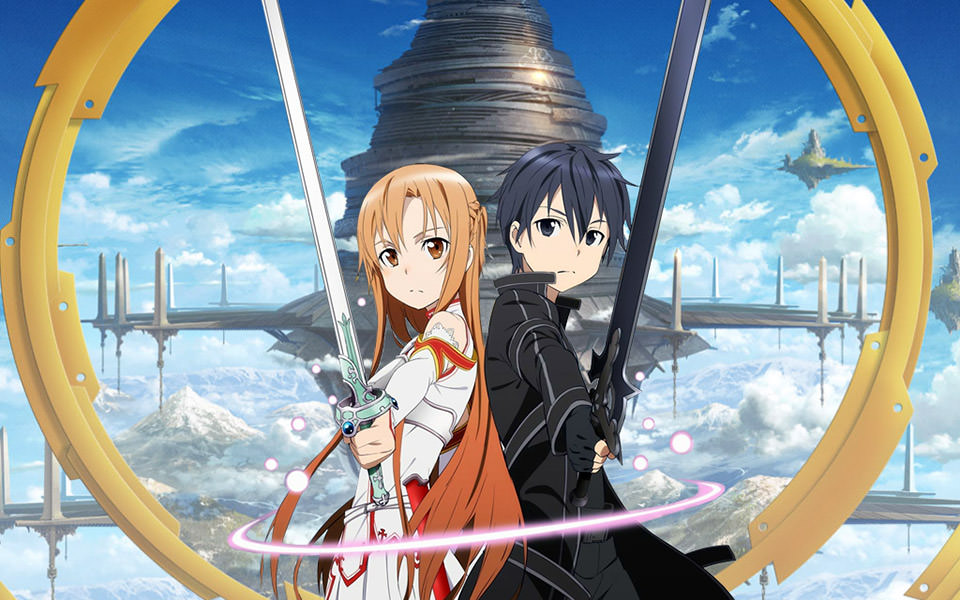Sword Art Online by Tomohiko Itō (Review)

My Christ and Pop Culture colleague Christopher Hutton has written several times about “digital dualism”, i.e., the (false) belief that people have that their online/digital lives are something separate from their physical/analog lives. Sword Art Online explores this concept in the guise of an anime series about an advanced MMORPG and the players stuck inside it, and it does so in an entertaining and whimsical-yet-serious manner. Well, up until the series’ second half, that is.
In the year 2022, gamers around the world are rejoicing over the release of Sword Art Online, an advanced virtual reality MMORPG that one plays with a special helmet that stimulates all of the senses. The game quickly surpasses everyone’s expectations with its incredible graphics, life-like simulations, and exciting combat. Unfortunately, it comes with a secret “feature”: it’s impossible to log out of the game. In order to leave the world of Sword Art Online, the players must defeat the final boss that resides on the 100th level of the game’s central tower. What’s more, if a player’s character dies in the game, or if someone in the real world disconnects them, they will die for real.
The first half of Sword Art Online (the anime, that is) does a decent job of realizing the promise of this set-up. While the series does some initial satirizing of video game tropes (e.g., ridiculous boss battles) that should be humorous for anyone who’s ever played a Japanese RPG, it also posseses an appropriate gravitas. It doesn’t gloss over the tragedy of thousands of players losing their lives or the survivors’ struggle with shock, guilt, and anger. The series is more involving and interesting thanks to this melancholy undercurrent.
Kirito — the series’ main protagonist — provides a good encapsulation of this approach. As a former beta tester (or “beater”), he is more experienced and skilled than many other players, which makes him a target of their anger and suspicion. But when he tries to hide his “beater” status so as to avoid being shunned, he ends up causing even more pain and fear, which compels him to become an infamous lone wolf player.
Sword Art Online doesn’t resort to high-minded philosophizing — this isn’t a Mamoru Oshii title, after all — but it plays with the notion of “digital dualism” and the grey area that can emerge, rightly and wrongly, between online and offline selves. Again, you won’t find any grandiloquent speeches regarding the nature of existence. Rather, there are lots of little scenes as characters reminisce about their offline selves and relationships, think through their new online existence, ponder the nature and reality of relationships that exist only within a digital realm (such as Kirito’s budding romance with Asuna, a young girl who is also a very skilled player), and come to terms with living in a world designed to give them the ultimate fantasy experience but which also possesses grave consequences for real.
Unfortunately, the series loses much of this substance, as well as its narrative steam, after the half-way point, when a rather large twist takes the series in a completely different direction.
For whatever reason, the anime’s producers decided to condense two arcs from Reki Kawahara’s popular light novel series into a single season. As a result, characters that we’ve come to like — including the series’ strongest female character — get sidelined in exchange for new characters and storylines that aren’t nearly as interesting or involving. Also, the “digital dualism” angle, with its interesting narrative possibilities, is ditched (for the most part) to make room for a more traditional “save the princess” narrative.
And while Sword Art Online had, up until this point, managed to avoid gratuitous fan service (an accidental groping scene notwithstanding), the second half incorporates shades of “harem” comedy as well as some annoying “love triangle” melodrama (that comes complete with vaguely incestuous overtones). Simply put, the second half feels like a completely different, and less interesting, series that is Sword Art Online in name only.
It’s unfortunate that things turn out this way, because the series’ first half delivered much and seemed poised for even better things. Sword Art Online may not have appeared to be all that substantial: at first glance, it looks like a rather straightforward hack n’ slash title, albeit one set in a video game rather than a more “traditional” fantasy setting. But that apparent shallowness was a bit subversive, allowing some depth to creep in when you weren’t expecting it. Kirito and Asuna’s relationship, Kirito’s relationship/reputation with other players, small hints at the game’s broader world and mythology, brief explorations of the political and economic systems created by the game’s players to survive, video game satire… all of these things made Sword Art Online — its first half anyway — more than the sum of its parts.
Fortunately, the twist that occurs in the series is so large and so abrupt that you can watch the first fourteen episodes, which contain the first storyline, as a self-contained experience and pretend that the rest of the episodes don’t exist. In fact, that’s precisely how I intend to think about Sword Art Online from now on.
Sword Art Online is currently streaming on Hulu and Crunchyroll.